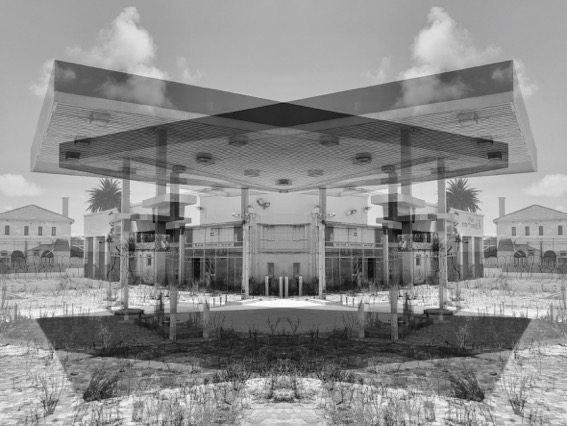Alastair Whitton: A Foreign Land
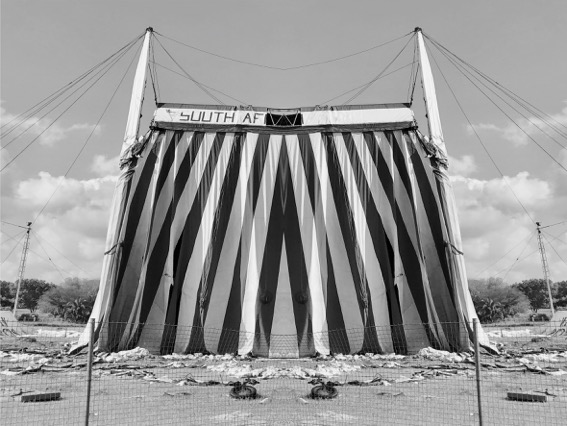
‘Tent, Black River’, 2019, Gelatin silver print, 300 x 400mm (image size), 320 x 420mm (paper size). Edition: 5 + 2 AP/s © Alastair Whitton Courtesy Black Box Publishing.
Photo London is delighted to present ‘A Foreign Land’, a photo narrative by South African photographer Alastair Whitton, accompanied by ‘Double Trouble’ an essay by Alexandra Dodd.
Essentially a portrait of Cape Town, a city in flux, this body of work is composed of 15 hand printed gelatin silver prints and considers what Alastair Whitton refers to as, ‘the mechanisms of memory and the mapping of geographies’. Through the lens, he explores ‘the architecture of time and the poetics and politics of place’. His photographs celebrate the seemingly commonplace and are in effect ‘monuments to the dislocated and overlooked’.
Black Box Publishing presents this series in its entirety at Photo London Digital.
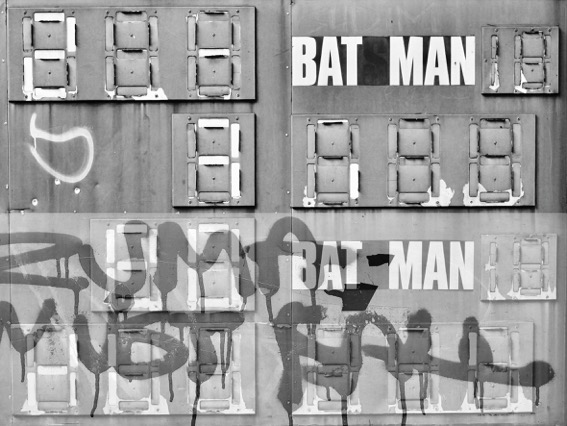
‘Batman & Zuma’, 2019, Gelatin silver print, 300 x 400mm (image size), 320 x 420mm (paper size). Edition: 5 + 2 AP/s © Alastair Whitton Courtesy Black Box Publishing.
Double Trouble
by Alexandra Dodd
This is not a love song. This is not that repeat-cycle dream of Cape Town as a transnational refuelling station, natural oasis, coastal escape, fantasy land of leisure and pleasure (lubricated, off set, by real estate muscle and strategic policing). Table Mountain is nowhere to be seen. The photographer has turned his back on the city’s insouciant iconicity in search of other pictures, different frames. There is no reversion to the easy reproducibility of familiar scenes and settings. And yet familiarity and reproduction do play a mysterious part in this unsettling sequence of peri-urban vistas. The series is shot through with doubling and reflection. But the replication is never automatic, the symmetry rarely exact.
We encounter multiple repetitions with difference. Familiar scenes have been manipulated or redacted by the photographer in ways that give rise to a double-take – a split-second instance of doubt about the veracity of the everyday. Is it, in fact, a split-second, or does the doubt linger? Does that concrete bus shelter really have so many sides? Is that fuel station really located in that weed-covered slab of deserted forecourt, or has it touched down like some alien slice of architectural fantasia from Dubai? Import. Export. The structure hovers there like some postmodern phantasm – a cut-and-paste figment of drive-by observation. Its form is at once outlandish and befitting of its rugged Cape Flats context. It both belongs there and doesn’t. This is the territory of Alastair Whitton’s A Foreign Land. The images invite a sense of recognition and meddle with prosaic assumptions, infusing the local with an undercurrent of impossibility and strangeness. Nothing quite adds up – not the place, nor the time.
Reconstructive memory
‘My projects are a long time in the making, which has to to do with the practical restraints of working multiple jobs – art director, curator and photographer,’ says Whitton. ‘But in a strange way, this has been helpful because it slows the whole process down. It slows down my looking, which is important as the projects I’ve worked on so far have essentially been about time; the passage of time and the mechanisms of memory – how your brain constructs or reconstructs a memory every time you recall it based on various stimulae. The information is the same and perhaps the immediate imagery or sense is the same, but your emotional filters make it different in highly nuanced ways. This has been central to my last three projects – but this one in particular.’
We might view our memories as being coherent, truthful, episodic accounts of our experiences, but the reconstructive process of memory involves cognitive glitches and errors. Like Whitton’s reconstructed settings, our memories are subject to distortion. Memory is never a literal recount of past experiences. Like a story that gets edited every time we recount it, memories are malleable constructs that are reconstructed anew with each recall, the retrieval restructured at every phase of the process. In each instance, the slightly changed memory becomes embedded as ‘real’, only to be reconstructed with the next recall – along with its associated feelings.
‘Each image is a memory,’ says Whitton. ‘Photography captures a moment that no longer exists and that will never exist again. So each image is a series of moments captured over time – in time – that were then reconstructed, layered over each other. An attempt to recreate a [remembered] sense of each place and space.’
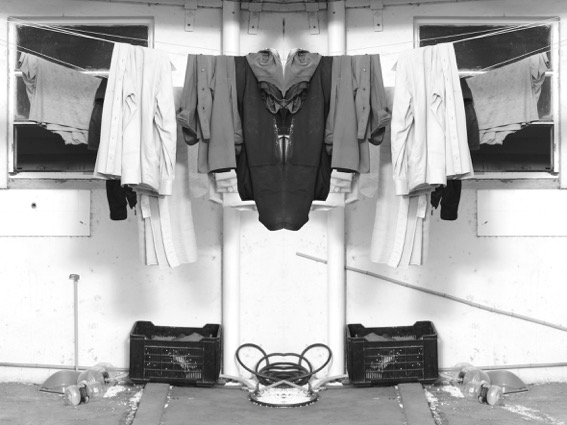
‘Washing Line’, 2019, Gelatin silver print, 300 x 400mm (image size), 320 x 420mm (paper size). Edition: 5 + 2 AP/s © Alastair Whitton Courtesy Black Box Publishing.
The photographer has much in common with the historian. Theirs is not the terrain of pure fabulation. Both consciously tether themselves to the idea of documentary reality. They are tied to the record. But the record in itself can be a fiction – biased, partial, limited. In a text entitled Bad Memories, Timothy Garton-Ash writes: ‘For the historian, the lesson is not just about the weakness of human memory, but about its fecundity, its infinite creativeness, its ability – no, its elemental compulsion – endlessly to rearrange the past in constantly shifting patterns.’ (1). These images are products of a similar kind of fecundity – generative rearrangements of the record to bring the documentary into closer alignment with the fundamental instability of memory itself.
‘I see my process as a form of visual archaeology. I’m interested in the mechanisms of memory, the mapping of geographies, the notion of private and public histories and how all these elements relate to or emanate from a physical space. I’m interested in the layering of history, so a lot of these locations are spaces I’ve frequented in my personal capacity over many years.’
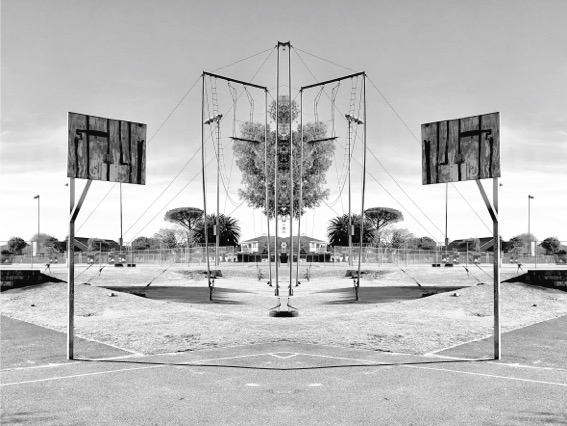
‘Playground 2’, 2019, Gelatin silver print, 300 x 400mm (image size), 320 x 420mm (paper size). Edition: 5 + 2 AP/s © Alastair Whitton Courtesy Black Box Publishing.
Some of the places depicted in the series are quite intimate, personal spaces for the photographer. ‘Playgrounds or parks where I walked my kids when they were small or where I taught them how to ride their bikes. There’s is a personal trace there, an emotional investment. At the same time, the memories are also collective because many other people have done the exact same thing. And places change over time. At times, when I go back to those spaces many years later, it can feel like I was never there. It’s a weird sensation – both foreign and familiar.’
But this weirdness is not just a function of the tricks that memory plays with one’s sense of a place. These images are shot through with different inflections of ‘foreignness’ – culturally produced feelings of alienation. It’s impossible to tell which is which, but they’re both part of the brew. Some of the images transmit a sense of transgression into spaces that are not the artist’s familiar playground, his known world. They are infused with an otherworldliness that is a product of the distance wrought by spatial apartheid.
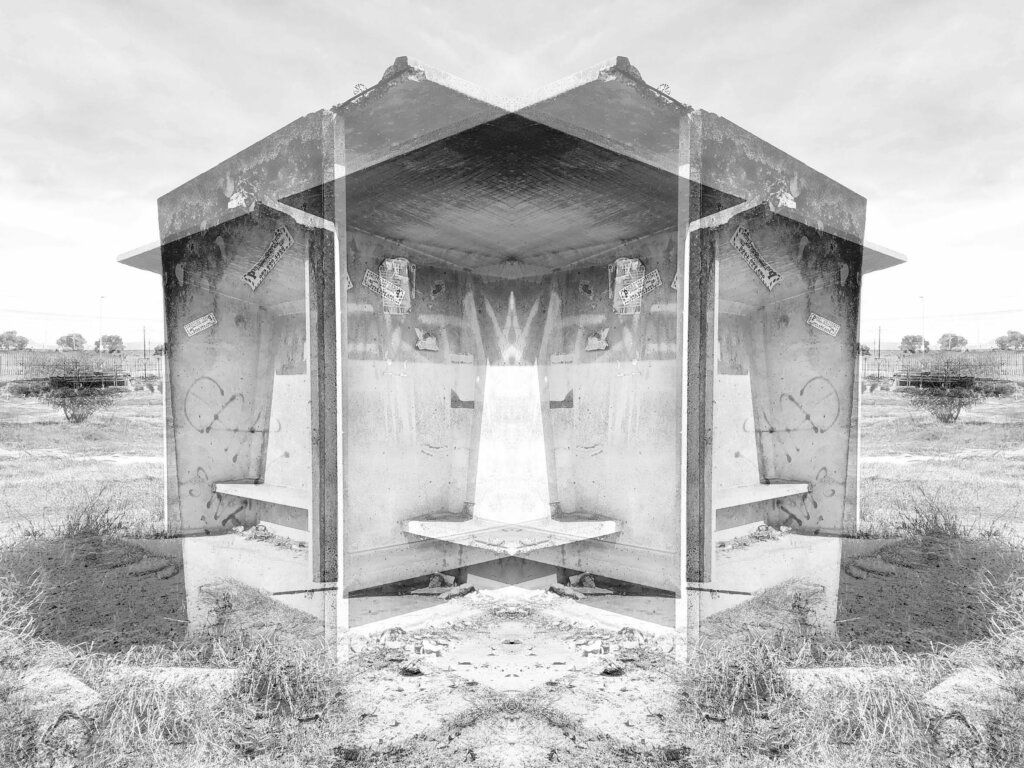
‘Bus shelter, Bonteheuwel’, 2019, , Gelatin silver print, 300 x 400mm (image size), 320 x 420mm (paper size). Edition: 5 + 2 AP/s © Alastair Whitton Courtesy Black Box Publishing.
‘There are locations in my images that are foreign because of the history of this country – and the divided history of Cape Town particularly. There are places I might not have gone to in the past. A place like Bonteheuwel, for example, is not the sort of place where I would go to just hang out. But I’ve driven through the perimeter of Bonteheuwel countless times because there’s a book binder and maker of handmade books out there that I work with. One day, I was there photographing a particular structure and there was this guy watching me from across the field. He came past me and gave me a wry smile and said something along the lines of: “Don’t worry, I’m not going to attack you.” It was humorous, but it was also quite sad and serious at the same time because there I was, a middle-aged white man in this field, and he must have been thinking that I was either very lost or strange. He saw the humour in it. But there was this sense of boundaries as well. This is not where you belong. You are in a foreign territory, but don’t worry, I’m friendly. You can’t remove or ignore that. It’s central. Every time I made an image, I was aware of the particular space – its past, as well as its present, the integration or non-integration of spaces and the transitioning of spaces.’
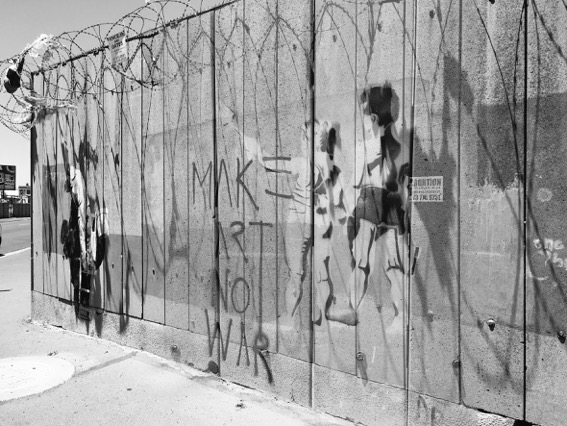
‘Wall (Make Art Not War)’, 2019, Gelatin silver print, 300 x 400mm (image size), 320 x 420mm (paper size). Edition: 5 + 2 AP/s © Alastair Whitton Courtesy Black Box Publishing.
There are other areas, like Woodstock, that Whitton travels through frequently to visit artists’ studios and galleries. ‘There’s a corner there that I’ve been passing by for about ten years as I’m driving through and there’s this particular wall that the taggers and graffiti artists really seem to like. I like the wall from a construction point of view. I love its materiality and its physicality. It’s quite severe and it’s got real presence. Perhaps that’s why they liked it too; it had a lot of open space for them to make their marks. And I found myself being pulled in by the language of their mark-making, so I started documenting these marks over the years. Marks pop up all over the city – some of them last for years or months, some of them only a week.
‘On this wall, there were particular images and tags that I liked, so I recorded them as individual images, and over the years, I started noticing how they shifted and got erased as other people brought their marks and then their marks got overlaid and rubbed out. When I went through my files, I realised that I’d documented all the images over time so I layered them together and recreated that wall. I went back there a couple of weeks back and the wall is still there, but everything has been completely erased. It is what it is, but it intrigued me.’
Anti-monument
In 1994, Mexican-Canadian electronic artist Rafael Lozano-Hemmer coined the term ‘relational architecture’ as the technological actualisation of buildings and the urban environment with alien memory. His intention was to transform the dominant narratives of certain buildings or urban settings by superimposing audio-visual elements onto them to affect them – re-contextualize them. From 1997 to 2006, starting with Displaced Emperors and ending
with Under Scan, Lozano-Hemmer built ten works of relational architecture. ‘I want buildings to pretend to be something other than themselves, to engage in a kind of dissimulation,’(2) he says.
Developed in opposition to the dominant narratives of monumental structures, anti- monumentalism (or counter-monumentalism) is a mode of art-making that denies the presence of imposing, authoritative social forces in public space. A particularly haunting example of an anti-monument is Jochen Gerz and Esther Shalev-Gerz’s 1986 Monument against Fascism, War and Violence – and for Peace and Human Rights in Harburg, a suburb of Hamburg in Germany. This 12m-high column invited passers-by to inscribe their names into its lead surface as a pledge to vigilance against fascism. In ‘Counter-monuments: the anti-monumental and the dialogic’, Quentin Stevens, Karen A. Franck and Ruth Fazakerley explain that the design of this ‘vanishing, self-consuming, anti-monument’ aimed:
… not to console but to provoke; not to remain fixed but to change; not be everlasting but to disappear; not to be ignored by its passersby but to demand interaction, not to remain pristine but to invite its own violation and desanctification; not to accept graciously the burden of memory but to throw it back at the town’s feet. The Harburg monument exceeded the artists’ own expectations about confronting tradition and sanctity. They had anticipated citizens adding their own names in neat rows, which would resonate with the conventions of memorials to the war dead. Yet people also scrawled banal graffiti, added funny faces, Stars of David and Swastikas, and tried to scrape away existing markings. Adding significance as a social mirror, a reminder of the public’s differing sentiments towards the troublesome past and toward attempts to commemorate it in the present. Over the course of several years, the column was gradually lowered into the ground, so that its existing markings disappeared and were refreshed with new ones. Lowered for the last time in 1993, all that remains of the column are the memories retained in people’s minds of the object and the issues and debates it provoked. (3)
Recalling the unruly graffiti scrawled across the disappeared surfaces of this anti-monument, graffiti, tagging and public mark-making are a second-skin language that runs through A Foreign Land, adding collective intent to the layers, textures and shapes that structure these images. The composite structures themselves bespeak permanence and impermanence in the same breath. Weathered and etched, they have survived the storms and seasons of human use and disregard. They’re crumbling, they’re warped, they’re disused, but they aren’t going anywhere. They are not a planning priority. Overlooked architectures of endurance, they persist in a vast no man’s land of civic neglect.
Twilight zone
A sense of dereliction leaks out across the images. They are deserted, depopulated – not a soul in sight. ‘I would wait for hours if needed to make sure that there was nobody in the picture,’ says Whitton. ‘The absence of people, in a strange way, heightens the presence of people’s imprints on a place and my own sense of wanting to understand the history of that space. All the spaces are connected to human beings. They’re all man-made structures that people clearly frequent. When I made these images I was grappling with memory – personal memory, but also imagining someone else who knows an area well – an individual, a family or a community that has frequented these spaces over time. What would their vision or take on it be?
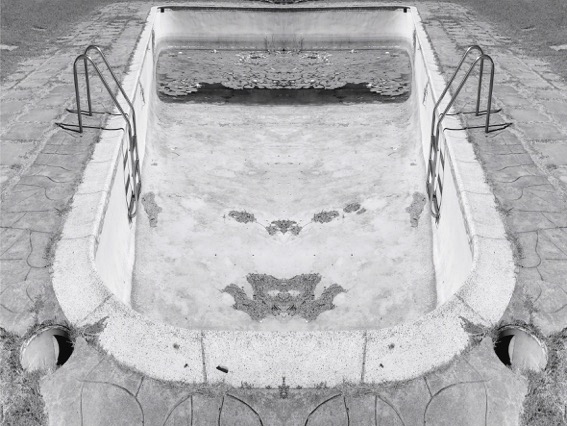
‘Pool’, 2019, Gelatin silver print, 300 x 400mm (image size), 320 x 420mm (paper size). Edition: 5 + 2 AP/s © Alastair Whitton Courtesy Black Box Publishing.
‘Every space is a space that someone or some community has trafficked, moved through, made their marks on… But I didn’t want to identify any specific person or people… I wanted to convey the idea that all these spaces – regardless of where you’re situated in the South African spectrum in terms of place, race, politics, all the complexities we deal with – all these spaces become foreign land to all of us. We can only recognise them in part, because there are just snatches and bits and tracings and layerings of different things, which are at once familiar and completely foreign. I think that is quite a South African condition.’
Unlike the motion of projection in Lozano-Hemmer work, the estrangement in Whitton’s A Foreign Land series is produced through the digital layering of archival stills. Yet, a similar kind of ‘dissimulation’ is at work here – a provocation to reconsider the urban wallpaper we routinely move past, whether in a car, on a bus or train, or on foot – to tear through the numbing flatness of the known and enter into the dimensionality that comes with seeing the post-apartheid (4) landscape through foreign eyes.
‘There’s a spot on De Waal Drive… I’ve been there so often; I think my car could go there on remote. There is a warning sign there that sometimes says something like, “If you drink and drive, you’re a killer” or something along those lines. But there never seem to be too many messages on it. From a sculptural point of view, I love that structure. It is somewhat bleak and absurd when looked at from a particular angle coming out of town. It looks out over the expanse of Cape Town towards Durbanville. There is this big blank structure, looming large and standing out so boldly. One day I looked up and saw that sign. And it came to me that it’s a warning sign, but there’s no warning – no sense of any communication. It was weird and ominous and I felt that it said something about this space, this country, this context – particularly Cape Town. So I reconstructed that image – left it blank. The notion of a warning sign that doesn’t give any warning. There was something in that that struck a chord.’
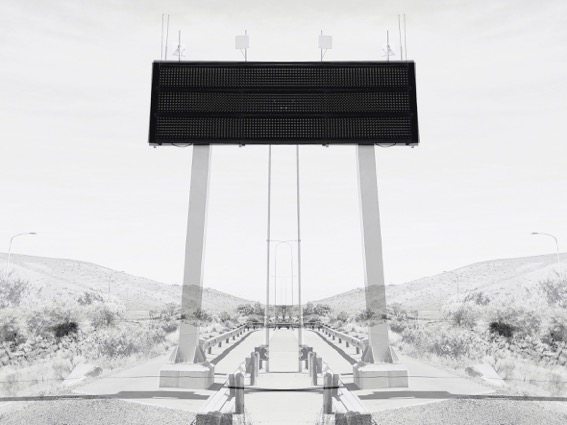
‘Warning sign, District Six’, 2019, Gelatin silver print, 300 x 400mm (image size), 320 x 420mm (paper size). Edition: 5 + 2 AP/s © Alastair Whitton Courtesy Black Box Publishing.
There is a twilight zone feeling that pervades many of the images in this series, some more than others – that sense of entering an area just beyond ordinary, legal or ethical limits. This slightly ominous quality of place has its peculiarly South African inflections and imprints, but it is by no means a feeling that is limited to the South African experience. Perhaps the haunting is heightened at particular moments in history. Perhaps it is no coincidence that the Twilight Zone television series written by Bryan Ells and screened between 1959 and 1964 has recently been remade by Simon Kinberg, Marco Ramirez and Jordan Peele. The new series premiered on CBS All Access in the United States in 1 April 2019. Perhaps it is no coincidence either that the series’ creators chose April Fools’ Day to premier it. Peele, a director who has achieved an international cult following through his chilling satirical horror films that explore the nightmarish aspects of being black in America, serves as the narrator of the series’ current incarnation.
Peele has much in common with Serling, the author of the original series, who as a boy, was a fan of pulp fiction. As an adult, he sought out topics such as the impacts of racism, government, war and society on human nature. He chose to combine these two preoccupations as a way of broaching off-limits subjects on television at a time when such issues were not commonly addressed. His most vocal complaints concerned censorship, which was frequently practised by sponsors and networks. Speaking of his 1957 Studio One production The Arena, intended to be an involving look into contemporary politics, he said: ‘To say a single thing germane to the current political scene was absolutely prohibited.’(5)
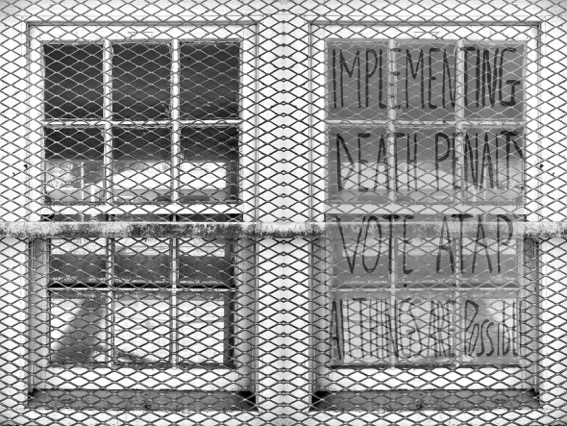
‘Window’, 2019, Gelatin silver print, 300 x 400mm (image size), 320 x 420mm (paper size). Edition: 5 + 2 AP/s © Alastair Whitton Courtesy Black Box Publishing.
The original Twilight Zone series, which ran on CBS for five seasons, was shot entirely in black and white, which added to the spooky, archival, time collapse quality of the series. Whitton’s adherence to the black-and-white aesthetic results in similar affective qualities. In fact, The Twilight Zone plot summary serves as an uncannily apt evocative description of the mood conjured by some of his more haunting composite images. It reads as follows:
The twilight zone is a place that exists at any moment of time, of space or of mind, but always when you least expect it. When you find yourself in this realm of unlimited possibility, be careful what you say or do. The right decisions may help you find your way back out… Sometimes with greater happiness and wealth. The wrong decisions often lead to madness and death, or an eternity trapped in this dimension. Tread warily past the signpost ahead that says you’ve entered. (6)
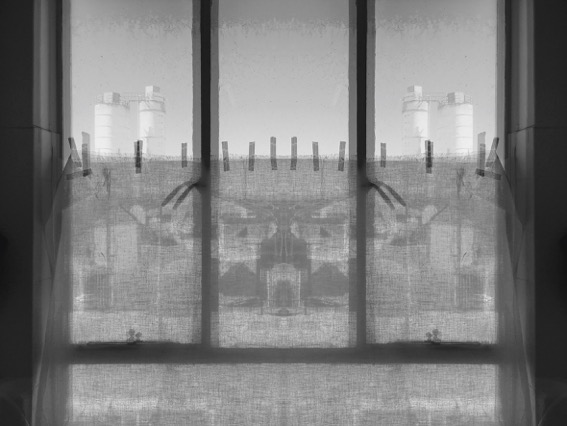
‘Interior’, 2019, Gelatin silver print, 300 x 400mm (image size), 320 x 420mm (paper size). Edition: 5 + 2 AP/s © Alastair Whitton Courtesy Black Box Publishing.

‘Tent, Black River’, 2019, Gelatin silver print, 300 x 400mm (image size), 320 x 420mm (paper size). Edition: 5 + 2 AP/s © Alastair Whitton Courtesy Black Box Publishing.
An image that powerfully transmits this eerie ‘twilight zone’ quality is Tent, Observatory. From recreational tents, to the tipis used by Native Americans and Aboriginal Canadians since ancient times, to the semi-permanent structures we see in the sprawling refugee camps built by governments and aid organisations to provide asylum to people fleeing from contemporary wars and disasters, tents could be understood as encompassing spaces of temporary shelter. This is not the energy emitted by the tent that dominates this frame. Fenced in and surrounded by litter, this tent gives the impression of being abandoned. Emptied out, its theatrical, candy-striped, ‘Punch and Judy’ curtains are roughly tethered to its scaffolding.
Tents have been used at least as far back as the early Iron Age. In the Book of Genesis, the first book of the Hebrew Bible and the Old Testament, for instance, Jabal, a descendant of Cain, is described as ‘the first to live in tents and raise livestock’(7). There is a Biblical air about this tent too – but it is more evocative of the makeshift tents that sprung up across the desert plains of Depression-era America housing evangelist sermons, circuses and all manner of motley magicians and snake-oil salesmen. Such tents are an occasional feature of the peri-urban fringes of many South African cities and towns – temporary installed to accommodate large assemblies of people attending weddings, funerals or seeking to alleviate their perpetual daily struggles through the intervention of charismatic spirit summonsed in spectacular sermons by Pentecostal preachers.
‘I was very fortunate with that image,’ says Whitton. ‘It was photographed down on the N2 freeway, as you’re travelling along the Black River – another road I drive along frequently. It’s an access point to the East Side of the City and sometimes I take that road when I know the one above it is going to be too busy.
‘It’s very near Valkenberg, which is a site that has always drawn me. It’s just opposite there. It’s not that I made a conscious link, but now that I think about it, that’s another area that I’ve often driven past. I drove in on one occasion and looked around,’ he says. Valkenberg Psychiatric Hospital was founded in 1891. ‘A “lunatic asylum”, as it was then called, was established to accommodate patients transferred from Robben Island. Robben Island had initially accepted patients to relieve pressure on Somerset and other hospitals, but reports of unhealthy conditions, overcrowding, and high suicide rates resulted in the decision to transfer care of patients to the Valkenberg site.’(8) Although it has undergone many reforms since then, and may well be a site of healing today, in popular consciousness and urban legend it remains haunted by the ghosts of colonial and apartheid madness, recalling those ‘wrong decisions [that can] lead to madness and death, or an eternity trapped in this dimension’ from the Twilight Zone plot summary.
‘I kept driving past this tent and wondering what on earth a circus tent was doing there,’ Whitton recalls. ‘It seemed like it hadn’t been used for years and years, which intrigued me, but I never took any pictures. I drove past it. Once I even drove to it, got out of the car and spent time there, but I wasn’t ready to take a picture. Then one day, I was driving past and something inside me knew I had to act immediately. So I documented what I had been looking at for so long. And the next week when I drove past, the whole thing was gone – disappeared. All that was left were the markings in the earth of what had been there. I wanted to document those markings that had been left behind, but the turf had been taken over by squatters and they were not receptive to me being there.
This anxious subtext of ambiguity speaks across these images. Through recorded markings and hovering abstract geometries, Whitton has succeeded in translating his own experience of uncertainty into an abstract pictorial language. You find yourself puzzling over the imperfect doubling that undoes the bilateral symmetry of the repeat Rorschach effect. If it is a double, why does that mark appear on the left and not the right? The impeccable mimesis of photography has been meddled with in ways that invite you to distrust your own instincts and assumptions. Are those goalposts really there? Clearly, nobody is keeping score. And you’re reminded, over and over again, that the Rorschach Test was a psychological test in the first place.

‘Playground’, 2019, Gelatin silver print, 300 x 400mm (image size), 320 x 420mm (paper size). Edition: 5 + 2 AP/s © Alastair Whitton Courtesy Black Box Publishing.
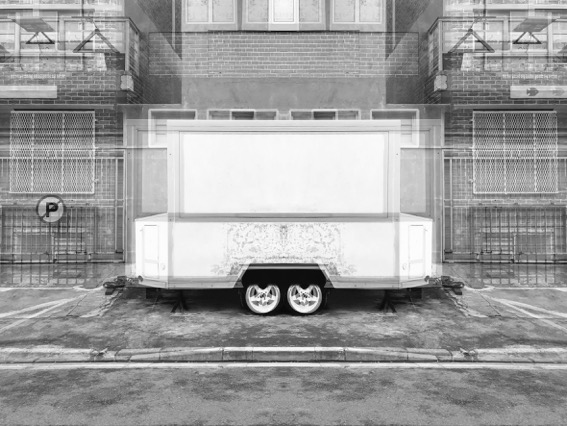
‘No Parking’, 2019, Gelatin silver print, 300 x 400mm (image size), 320 x 420mm (paper size). Edition: 5 + 2 AP/s © Alastair Whitton Courtesy Black Box Publishing.
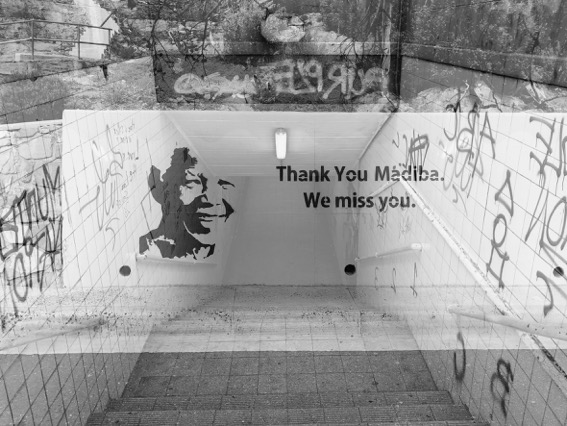
‘Subway’, 2019, Gelatin silver print, 300 x 400mm (image size), 320 x 420mm (paper size). Edition: 5 + 2 AP/s © Alastair Whitton Courtesy Black Box Publishing.
Biographies:
British born South African photographer Alastair Whitton’s work considers the mechanisms of memory and the recording of time and place. Through the lens, he explores what he refers to as ‘the architecture of time and the poetics and politics of place’. His photographs celebrate the seemingly commonplace and are in effect monuments to the dislocated or overlooked. To date he has presented solo exhibitions in Paris, Cape Town and Johannesburg. His work has been featured in curated group exhibitions at notable museums and institutions in South Africa and abroad. In the past decade these have included amongst others: Fotomuseum, Antwerp; Pratt Institute, New York; Calouste Gulbenkian Museum, Lisbon; The Center for Book Arts, New York; Museo Carlo Bilotti, Rome; Fondazione Giorgio Cini, Venice; Carreau du Temple, Paris; National Museum of Mali, Bamako; Johannesburg Art Museum, Johannesburg and IZIKO South African National Gallery, Cape Town. Whitton’s work is represented in the collections of the University of South Africa, Durban Art Museum, Durban Institute of Technology, Jack Ginsberg Collection, Ampersand Foundation, National Museum of Mali, Luciano Benetton Collection and the Aperture Foundation Library Collection in New York. www.blackboxpublishing.photography
Alexandra Dodd is a writer and editor whose work takes shape at the interface between visual, literary and archival cultures. She holds a Master of Arts from Concordia University, Montreal, Canada, and a PhD in Literature from the University of Cape Town. She is currently a Postdoctoral Fellow in the National Research Foundation SARChI (South African Research Chair Initiative) in Social Change at the University of Fort Hare. Alexandra is the author of David Goldblatt: The Last Interview (Steidl, 2019).
Notes:
(1) Garton Ash, T. 1999. ‘Bad Memories’, History of The Present: Essays, Sketches, and Dispatches from Europe in the 1990s, Random House: New York, p. 248–253.
(2) Adriaansens, A. and Brouwer, J. ‘Alien Relationships from Public Space’ in TransUrbanism. Rotterdam: V2_Publishing /NAI Publishers, 2002. 152–154.
(3) Stevens, Q., Franck, K.A., & Fazakerley, R. 2012. ‘Counter-monuments: the anti-monumental and the dialogic’, The Journal of Architecture, 17:6, 951–972, DOI: 10.1080/13602365.2012.746035 (952–954).
(4) In employing the term ‘post apartheid’ it is worth holding in mind the temporal discontinuity of traumatic cultures and reflecting on comparative literature professor and cultural memory theorist Marianne Hirsch’s understanding of the shared prefix ‘post’ in critical terms, like ‘postmemory’, ‘postsecular’, ‘posttraumatic’, ‘post apartheid’ and ‘posthuman’, that continue to shape our intellectual landscape. Drawing attention to the ‘layering and belatedness’ inherent in this prefix, she points to the ‘practices of citation and supplementarity’ that characterise its use, arguing that:
‘Postmodernism’ and ‘poststructuralism’, for example, inscribe both a critical distance and a profound interrelation with modernism and structuralism; ‘postcolonial’ does not mean the end of the colonial, but its troubling continuity… (Hirsch, M. 2012. The Generation of Postmemory: Writing and Visual Culture After the Holocaust. New York: Columbia UP. 5)
In as much as the ‘post’ in ‘postcolonial’ signals a ‘profound interrelatedness’ and ‘troubling continuity’ with colonialism, it also subtly binds the notion of the ‘postcolonial’ to related concepts like ‘posttraumatic’, ‘postapartheid’, ‘postmodern’, highlighting the interrelationship between these conceptual worlds. In none of these instances does the ‘post’ denote a concession to sequential logic or linear temporality. Rather, it signals precisely the kind of ‘interlocking of presents, pasts and futures’ about which Achille Mbembe writes (Mbembe, A. 2001. ‘Time on the Move.’ On the Postcolony. Berkeley: University of California Press.16.).
(5) ‘Television history: background.’ The Twilight Zone. https://en.wikipedia.org/wiki/The_Twilight_Zone (last accessed 31 January 2020).
(6) Ells, B. ‘Storyline.’ The Twilight Zone. https://www.imdb.com/title/tt0052520/ (last accessed 31 January 2020).
(7) Genesis 4:20
(8) 2006. ‘Valkenberg Hospital: The New Admission Unit.’ Western Cape Government: Better Together. https://www.westerncape.gov.za (last accessed 31 January 2020).
To access the full length talk you need to be registered and logged in.

